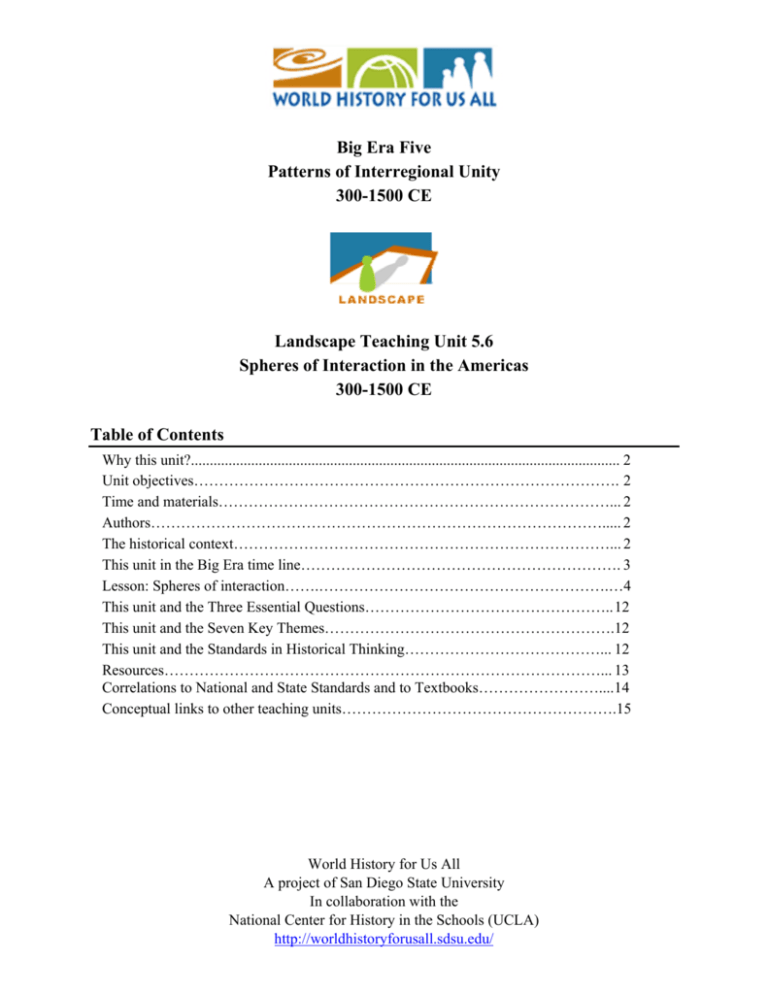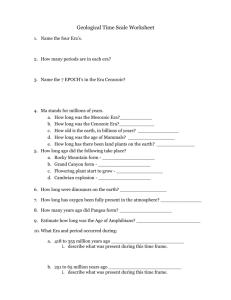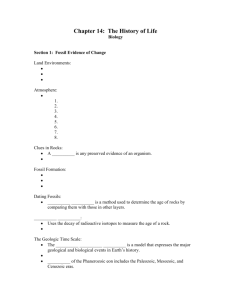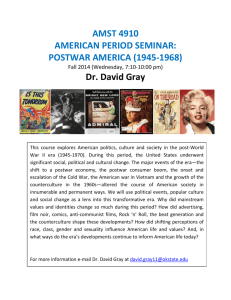
Big Era Five
Patterns of Interregional Unity
300-1500 CE
Landscape Teaching Unit 5.6
Spheres of Interaction in the Americas
300-1500 CE
Table of Contents
Why this unit?.................................................................................................................. 2
Unit objectives…………………………………………………………………………. 2
Time and materials……………………………………………………………………... 2
Authors………………………………………………………………………………..... 2
The historical context…………………………………………………………………... 2
This unit in the Big Era time line………………………………………………………. 3
Lesson: Spheres of interaction…….………………………………………………….…4
This unit and the Three Essential Questions………………………………………….. 12
This unit and the Seven Key Themes………………………………………………….12
This unit and the Standards in Historical Thinking…………………………………... 12
Resources……………………………………………………………………………... 13
Correlations to National and State Standards and to Textbooks……………………....14
Conceptual links to other teaching units……………………………………………….15
World History for Us All
A project of San Diego State University
In collaboration with the
National Center for History in the Schools (UCLA)
http://worldhistoryforusall.sdsu.edu/
World History for Us All
Big Era 5 Landscape 5.6
Why this unit?
Networks of trade and exchange have been an important feature of world history. This was true
both in Afroeurasia and the Americas. People not only acquired goods they needed and wanted
from outside their immediate region, but they also received technological, religious, and other
ideas from the people with whom they had contact. In this unit, students will learn that by Big
Era Five (300-1500 CE) indigenous peoples of the Americas had developed extensive networks
of trade and exchange. They will also learn that they accomplished this even though they had no
pack animals (except for llamas in the Andes), no wheels, and no carts.
We tend to think of our contemporary world as unique with regard to the web of connections we
share with others around the globe. It is important for us to remember that connections between
different human societies have always been a feature of world history. What is different today is
only the complexity and speed of our interconnections.
Unit objectives
Upon completing this unit, students will be able to:
1. Identify and locate spheres of interregional exchange in the Americas.
2. List examples of goods exchanged within spheres.
3. Explain how goods were exchanged and transported over a wide geographic area.
4. Describe theories about which spheres might have been linked through trade.
Time and materials
•
•
This lesson takes approximately 30-45 minutes.
Materials need include an atlas, map, and the Student Handouts
Authors
Felicia Eppley taught history at Lamar High School in Houston, Texas. She received a FulbrightHays Fellowship for summer study in India, and she has traveled widely in Europe, Africa, and
Asia. She contributed to Teaching World History: A Resource Book edited by Heidi Roupp
(M.E. Sharpe, 1997).
Ellen Leader Pike teaches history at Lancaster Country Day School in Lancaster, Pennsylvania.
She was a Klingenstein Fellow at Teachers College, Columbia University, and she authored
“Bringing the World History Standards into the classroom,” Social Studies Record 35 (1998).
http://worldhistoryforusall.sdsu.edu/
Page 2
World History for Us All
Big Era 5 Landscape 5.6
The historical context
Implicit in the presentation of the arrival of Europeans in the Americas in most history texts is
the idea that this encounter marked the first time that people of different societies came in
contact in this world region. In fact, between 300 and 1500 CE, indigenous peoples of the
Americas established complex networks of trade and exchange. Within North America,
Mesoamerica, and the Andean regions, trade routes developed that carried food, minerals,
manufactured goods, and ideas over long distances either by foot or water.
In North America, many zones of interconnection and interaction existed: the Northern and
Eastern Woodlands, the Southeast and the Southwest, and the Pacific Northwest are examples. In
Mesoamerica, peoples of the valley of central Mexico had trade contacts with peoples to the
north of them and beyond to the desert regions of northern Mexico and the American southwest.
They traded to the south, the Yucatan Peninsula, into Central America. In the Andean region of
South America, peoples whose communities were strung along the mountain cordillera
established networks of exchange with those to the north and south of them and with those lower
or higher elevations. In addition, there is some speculation that peoples of the Ecuadorian region
were intermediaries in systems of exchange between Mesoamericans and northern Andeans.
This unit in the Big Era time line
Big Era Five 300-1500 CE
300-1500 CE
http://worldhistoryforusall.sdsu.edu/
Page 3
World History for Us All
Big Era 5 Landscape 5.6
Lesson
Spheres of Interaction
Background Information for Teacher
This lesson is suitable for students in grades 6-12 with modifications. Archaeological research
and analysis have yielded most of the information we have about networks of trade and exchange
in pre-Colombian America. By examining changes in styles of art and architecture, materials
used in manufacturing objects, and fossilized natural materials, archaeologists are able to
speculate about likely networks of interactions
Trade vs. Economic Networks and Systems of Exchange: Since the word “trade” seems to
conjure up contemporary images of buying and selling through specialized merchants on a one to
one basis, it does not exactly describe what these early traders were doing. Goods often traveled
over great distances and changed hands so many times that it would be difficult to trace the exact
route of a particular item. Complex webs of exchange often meant that goods followed circuitous
routes and passed through many hands from their point of origin to their final destination. Also,
exchange might take the form of political tribute to rulers or gift-giving as an aspect of
diplomacy.
Local vs. long distance trade: The basis of local exchanges was the household needs of
ordinary people, while long distance trade tended to satisfy the desires of elites and rulers. Since
local environments determined which plants, animals, and mineral resources were available,
people began to exchange their local surpluses with people nearby for goods they wanted.
Local trade: It favored bulky and heavy items such as pottery, baskets, minerals, and wood, as
well as farm products such as maize, beans, or fruits. It was feasible to transport bulky items over
short distances but not over long ones. In local trade there tended to be a reciprocal exchange of
goods of equal value, so one type of food might be bartered for another. Over longer distances
there was usually a local “medium of value, for example, cacao shells or gold dust in quill
containers in Mesoamerica, coca or maize in the Andes, and seashells or beaver pelts in parts of
North America.
Long distance trade: This was mainly in luxuries and exotics for elites and rulers. Artisans
working for them needed a wide range of raw materials that many times were not available in
their local areas. For example, those in lowland regions had no local sources of minerals to be
made into tools or weapons. Foods were specific to particular climates, so if people wanted to
have a balanced diet or satisfy a taste they desired, they would have to acquire food from
external areas outside of their region. Long distance trade items tended to be light in weight and
valuable (such as feathers, jewels, or ornaments). Possessing exotic and valuable goods
sanctioned elites’ rule by showing evidence of their status and worldliness.
Transportation: Goods were most often transported overland. In Mesoamerica, for example,
porters might carry up to fifty pounds and cover fifteen miles a day through jungles, across steep
http://worldhistoryforusall.sdsu.edu/
Page 4
World History for Us All
Big Era 5 Landscape 5.6
ravines, and up rugged mountains. The Andean region was the only one in the America that had
a pack animal, the llama, which could carry only a moderate weight of up to about 100 pounds.
In addition, coastal and river-dwelling peoples had various types of floats, boats, canoes, and
rafts. In some cases specialized merchants employed caravans of porters to carry goods. In other
cases individual traders made long trips.
Chocolate: In Mesoamerica cacao was highly valued because it was considered to be a
stimulant, an intoxicant, a hallucinogen, and an aphrodisiac. The caffeine in chocolate certainly
was a stimulant, and warriors used it for strength before a battle. When fermented it could be
intoxicating. During religious festivals, hallucinations could be induced with fermented
chocolate teamed with certain mushrooms. Rulers, like Montezuma, drank chocolate before
making love to one of his many wives.
Raw chocolate is quite bitter. Mesoamericans mixed it with combinations of spices, peppery
flowers, bitter almond-tasting seeds, and limewater. Maize was used to thicken chocolate.
Chocolate was rare. It grew in tropical lowlands and production was limited. It was therefore
used as money throughout Mesoamerica. Records exist of counterfeit cacao beans. Individuals
would empty cacao bean shells and then fill them with clay to pass them off as the real thing.
Procedures
1. Put Student Handout 1 (Spheres of Interaction in the Americas) on the overhead and ask
students to identify the three major regions of intercommunication: Eastern North America,
Mesoamerica, and the Andes.
Note to teachers: Point out to students that the Mesoamerican sphere included a chunk of the
southwestern United States. The Eastern North American sphere extended from the Rockies
to the Appalachians and from the Great Lakes to the Gulf of Mexico. The Andean sphere
included the mountains and coastal plains of western South America, so that trade in this
region was not only horizontal, but also “vertical.”
2. Put students into small groups.
a. Give each group a list of trade items for one of the three spheres (Eastern North
American, Mesoamerican, or Andean). Ask students to organize the items into these
categories: Food, Raw Materials, and Manufactured Items.
b. Have groups report and write a categorized list for each sphere on the board.
Ask students to suggest how an archeologist might determine which of the items were
likely to be locally produced and which would have come from some distance. List
these suggestions on the board and discuss their validity. Possibilities might include:
Foods and animal products that could not be locally produced because the
environment was too hot, too cold, too dry, too wet, or too high.
http://worldhistoryforusall.sdsu.edu/
Page 5
World History for Us All
Big Era 5 Landscape 5.6
Pottery and textiles that have designs on them do not always match the local
designs. Such designs tend to be very localized due to the types of clays and
coloring agents used on them (i.e., pigments and dyes).
Marine shells found inland.
Metals and stones were found far from their sources. Mesoamericans acquired
turquoise from the area that is now known as New Mexico. Andeans obtained
emeralds from the area that is now known as Ecuador.
3. Have each group examine its sphere in an atlas.
a. Make a list of the positive features of the area the group chose in terms of transport
routes (e.g., navigable rivers) and obstacles (e.g., mountain ranges). Hypothesize
about what obstacles, other than climate and topography, might pose problems to
traders (e.g., local wars, diseases, etc.).
b. Hypothesize how goods could be moved from one place to another within the trade
area. Have students report their answers by region.
4. Put Student Handout 1 on the overhead again. Give each group copies of the information on
the two spheres they did not work on. Each group should now have copies of items from all
three spheres. Ask students to compare the items and consider the following questions:
a. Are there any items that might indicate trade between the spheres?
b. How would the items be transported from one place to another?
c. Would the exchange have been direct or might there have been an intermediary?
Note to teachers: One obvious interconnection among these three spheres is maize. Scientists
have shown from genetic evidence that maize originated in Mesoamerica and from there spread
to upper North America and to South America. Other connections are not as well documented,
but there are a number of theories about them:
a. Ecuador, located at the northern edge of the Andean sphere, acted as an intermediary
between that region and the southern edge of the Mesoamerican sphere. Evidence
includes the Spondylus princeps shell. (Go to an Internet search engine to find
pictures of Spondylus princeps to show students what it looks like.) These were used
in both Ecuador and western Mexico for religious purposes, and were traded from
Ecuador south to people in the Andes. Shaft tombs of the same unusual design and
figurines of people wearing similar clothing are found both in western Mexico and
Ecuador.
b. A connection is thought to exist between Mesoamerica and the North Eastern
American sphere because of suggestive evidence from architecture. The temples of
the Mississippian peoples were built on large earthen temple-mounds shaped like the
stone temple-mounds of Mesoamerica. Students can look at the map and hypothesize
the possible routes these exchanges might have taken.
http://worldhistoryforusall.sdsu.edu/
Page 6
World History for Us All
Big Era 5 Landscape 5.6
Assessment
Students should locate on a map the three major spheres of interaction in the Western
Hemisphere. They should be able to define local and long distance trade, provide examples of
both, and explain how items would have been transported. Finally, students should cite an
example of a possible regional exchange.
Extension Activities
a. Ask students to measure the dimension of their region. How far would an item have
to travel to get from one end of the region to the other? Note: These measurements
might be saved for a later comparison of trade routes in Afroeurasia. Were these
zones longer or shorter than those in Afroeurasia? Were the conditions similar or
different? What kind of transportation was used and what items were traded?
b. We know about the economic benefits of systems of exchange. Ask students to
discuss the political, social, and cultural aspects as well.
c. Ask students to research the mound-building societies of North America and try to
determine whether or not they think these societies meet the criteria of a civilization
as described in Big Era Three.
http://worldhistoryforusall.sdsu.edu/
Page 7
World History for Us All
Big Era 5 Landscape 5.6
Student Handout 1
Map: Spheres of Interaction in the Americas: 300-1500 CE
Microsoft®Encarta®Reference Library 2002. ©1993-2001 Microsoft Corporation. All rights reserved.
http://worldhistoryforusall.sdsu.edu/
Page 8
World History for Us All
Big Era 5 Landscape 5.6
Student Handout 2
Andean Items of Exchange
Monkeys
Maize
Silver ornaments
Potato
Quinoa
Pottery
Coca
Manioc
Tools (obsidian - points, knives, and scrapers)
Peppers
Dried Meat
Gold ornaments
Sweet Potatoes
Yams
Tropical fruits
Beans
Peanuts
Feathers
Tomatoes
Dried fish
Guinea pigs
Shell beads
Avocados
Salt
Textiles (wool, cotton)
Spondylus princeps sea shells
http://worldhistoryforusall.sdsu.edu/
Page 9
World History for Us All
Big Era 5 Landscape 5.6
Student Handout 3
Mesoamerican Items of Exchange
Fish
Pottery
Bird feathers [quetzal and macaw]
Animal skins
Stones: [jade, jadeite, turquoise, crystalline, Yellow topaz, obsidian]
Flint
Metals [gold and copper]
Spondylus princeps sea shells
Honey
Combs
Feathered head gear and shields
Nose and ear rings
Textiles
Bells
Needles
Cochineal [insects that are used for red dye]
Red ochre
Herbs
Slaves
Copal [used for incense]
Rubber
Jaguar pelts
Flint
Honey
Ear plugs
Salt
Fish
Pottery
Canoes
Game
Wooden statues of gods
Maize
http://worldhistoryforusall.sdsu.edu/
Page 10
World History for Us All
Big Era 5 Landscape 5.6
Student Handout 4
Eastern North American Items of Exchange
Maize
Beans (kidney, navy, pinto, pole, snap)
Chert hoes and spades
Marine shell spoons, dippers, and vessels
Copper Ornaments
Freshwater pearls
Obsidian tools
Mica
Pottery
Baskets
Shell beads and pendants
Furs
Bone needles, awls
Game
Dried Fish
Tobacco
Stone pipes
Leather garments
Pigments
Flint knives, scrapers, and drills
http://worldhistoryforusall.sdsu.edu/
Page 11
World History for Us All
Big Era 5 Landscape 5.6
This unit and the Three Essential Questions
Why do you think population in
South America in Big Era Five was
so heavily concentrated in the
Andean region in contrast to
relatively low populations in other
parts of the continent, especially
the great Amazon River basin?
Why might peoples of the Americas have lacked incentives to invent the wheel,
which we think of today as such a basic tool? How did American peoples
compensate for the absence of wheels (except, it appears, as toys)? Did many
different peoples in Afroeurasia invent the wheel, or did it happen independently
only in one or a few places?
The jaguar was a supernatural being in many Mesoamerican societies. What
qualities and powers did the jaguar typically have? What was the range in time
and space of the jaguar deity in Mesoamerican religion? What might the
appearance of the jaguar deity in different societies tell us about human
exchange networks in Mesoamerica?
This unit and the seven Key Themes
This unit emphasizes:
Key Theme 2. Economic Networks and Exchange
Key Theme 7. Science, Technology, and the Environment.
This unit and the Standards in Historical Thinking
Historical Thinking Standard 1: Chronological Thinking
The student is able to (F) reconstruct patterns of historical succession and duration in which
historical developments have unfolded, and apply them to explain historical continuity and
change.
Historical Thinking Standard 2: Historical Comprehension
The student is able to (G) draw upon data in historical maps in order to obtain or clarify
information on the geographic setting in which the historical event occurred, its relative and
absolute location, the distances and directions involved, the natural and man-made features of the
http://worldhistoryforusall.sdsu.edu/
Page 12
World History for Us All
Big Era 5 Landscape 5.6
place, and critical relationships in the spatial distributions of those features and historical event
occurring there.
Historical Thinking Standard 3: Historical Analysis and Interpretation
The student is able to (D) draw comparisons across eras and regions in order to define enduring
issues as well as large-scale or long-term developments that transcend regional and temporal
boundaries.
Historical Thinking Standard 4: Historical Research Capabilities
The student is able to (C) interrogate historical data by uncovering the social, political, and
economic context in which it was created; testing the data source for its credibility, authority,
authenticity, internal consistency and completeness; and detecting and evaluating bias, distortion,
and propaganda by omission, suppression, or invention of facts.
Historical Thinking Standard 5: Historical Issues-Analysis and Decision-Making
The student is able to (C) identify relevant historical antecedents and differentiate from those that
are inappropriate and irrelevant to contemporary issues.
Resources
Instructional resources for teachers
Brown, James A., Richard A. Kerber and Howard Winters. “Trade and the Evolution of
Exchange Relations at the Beginning of the Mississippian Period.” In Bruce D. Smith,
ed., The Mississippian Emergence,. Washington, D.C. : Smithsonian Institution Press,
1990: 251-280.
Bruhns, Karen Olsen. Ancient South America. Cambridge: Cambridge University Press, 1994.
Guillero, A. Cock. “Inca Rescue.” National Geographic. May, 2000, pp. 78-91. Several
mummies from an Incan graveyard were found buried with items from other regions.
The Cambridge History of the Native Peoples of the Americas. 4 vols. Cambridge: Cambridge
University Press, 2000.
Mayer, Enrique. The Articulated Peasant: Household Economies in the Andes. Boulder, CO:
Westview Press, 2002.
Smith, Michael E. and Marilyn A. Masson, eds. The Ancient Civilization of Mesoamerica: A
http://worldhistoryforusall.sdsu.edu/
Page 13
World History for Us All
Big Era 5 Landscape 5.6
Reader. Malden, MA: Blackwell, 2000.
http://worldhistoryforusall.sdsu.edu/
Page 14
World History for Us All
Big Era 5 Landscape 5.6
Instructional Sources for Students
Guillero A. Cock. “Inca Rescue.” National Geographic. May, 2000, pp. 78-91. Several
mummies from an Incan graveyard are found buried with items from other regions.
Correlations to National and State Standards and to Textbooks
National Standards for World History
Era Five: Intensified Hemispheric Interactions, 6A: The student understands the development of
complex societies and states in North America and Mesoamerica.
California: History-Social Science Content Standards
Grade Seven, 7.7.1: Study the locations, landforms, and climates of Mexico, Central America,
and South America and their effects on Mayan, Aztec, and Incan economies, trade, and
development of urban societies.
New York: Social Studies Resource Guide with Core Curriculum
Unit One: Ancient World – Civilizations and Religions (4000 BC – 500 AD), C. 5 Rise of
agrarian civilization in Mesoamerica—Mayan (200 BC-900 AD).Unit Four: The First Global
Age (1450-1770), D. The rise of Mesoamerican empires. Aztec and Incan empires before 1500.
Texas Essential Knowledge and Skills for Social Studies
113.33 World History Studies. (c) Knowledge and Skills. 6) History. The student understands the
major developments of civilizations of sub-Saharan Africa, Mesoamerica, Andean South
America, and Asia.
Virginia History and Social Studies Standards of Learning
World History and Geography to 1500 AD. Era IV: Regional Interactions, 1000-1500 A.D.
WHI.11 The student will demonstrate knowledge of major civilizations of the Western
Hemisphere, including the Mayan, Aztec, and Incan, by a) describing geographic relationship,
with emphasis on patterns of development in terms of climate and physical features; b)
describing cultural patterns and political and economic structures.
Textbooks
Across the Centuries (Houghton Mifflin). Chapter 16: Two American Empires. Lesson 1: The
Aztec.
World History: Patterns of Interaction (McDougal Littell). Chapter 16: People and Empires in
the Americas.
World History: The Human Experience (Glencoe McGraw-Hill). Chapter 15: The Americas.
Lesson 3: The Aztec and Inca Empires.
http://worldhistoryforusall.sdsu.edu/
Page 15
World History for Us All
Big Era 5 Landscape 5.6
Conceptual links to other teaching units
This teaching unit connects effectively to the Panorama Teaching Unit for Big Era Six, the
period when the Americas and Afroeurasia became permanently linked. The Great World
Convergence brought momentous changes to the Americas, for example, in the food products
that people consumed and traded.
http://worldhistoryforusall.sdsu.edu/
Page 16












